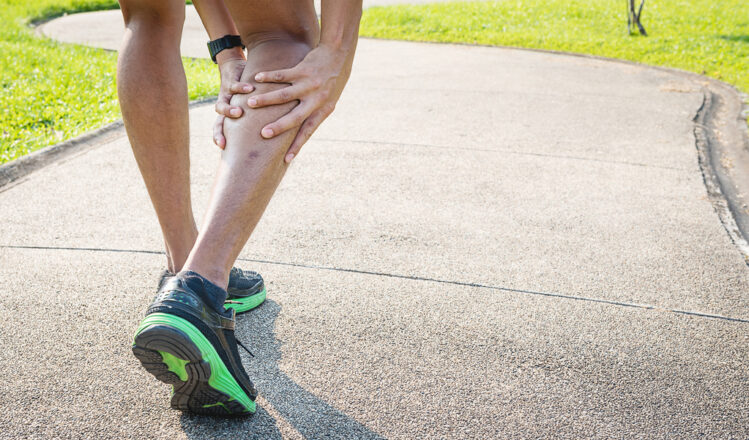While running involves a good percentage of the musculature in your body, your calves always seem to take the brunt of the work. This leads to many people asking why their calves get so sore while running and what can be done to lessen these effects. Let’s take a look at what we can do to relieve calf pain from running and some signs that the soreness may indicate a more serious injury.
In This Article:
Why Are My Calves So Sore After the Run?
Running is inherently tough on your calves because they are going through countless reps through the run duration. Breaking down running into its biomechanical movements, each stride is like repetition for the calf musculature. Each push-off from the balls of your feet and toes creates a concentric contraction in the calf.
Anyone who has exercised in any form knows that repeated bouts of effort in the form of concentric and eccentric contractions can lead to soreness from fatigue and microtrauma to the muscles used. This damage causes the muscles to repair and recover to a better state than before to be prepared for the next time that stress is placed on them.
The more you push yourself on the run, the more you are on the forefront of your feet, using your calf muscles to push harder with each stride. This acts as progressive overload, which is known to cause soreness regardless of the resistance used.
When Should I Be Concerned About Sore Calves?
A lasting soreness beyond a few days, not including delayed onset muscle soreness (DOMS) following a period of inactivity, can be a sign that you have a pulled calf muscle. A torn calf muscle is typically easy to spot, as the sharp pain is almost instantaneous to the tear.
If you can’t walk or stand up on your toes without sharp pain, you may have a pulled calf muscle. Treat your injuries according to the direction of your healthcare provider. Otherwise, regular soreness from the intense exercise of running can be treated at home.
How Do I Loosen Up My Sore Calves?
One of the best ways to reduce soreness is to get more blood flow to the area to clear out waste products produced from running. These waste products build up and increase the rate of soreness if they aren’t efficiently removed. That’s why a cool-down after a run, along with flexibility and mobility work, is a great idea for all runners.
There are quite a few drills to use to loosen up tight calves, including:
- Static stretching (only for use after a run, not before)
- Dynamic stretching
- Ankle mobility drills
- Strengthening your tibialis anterior (muscle along your shin) to create better lower-leg balance
- Massage
- Compression
- Contrast bath therapy
You don’t have to apply these before and after each run to reduce the onset of soreness in your calves. Simply find a few that work great for a warm-up and/or cool-down and use them to enhance your calf muscle recovery from running.
How Do I Know if My Calf Pain Is Serious?
A pulled calf muscle is the most common affliction in the calves for runners. It’s a slight tear in your calf muscle that goes beyond the microtrauma from exercise. Here are a few signs that your soreness isn’t just a result of good training:
- Swelling
- Bruising
- Sharp pains when attempting to walk or stand on the balls of your feet
- Redness on the calf itself
With a pulled calf muscle, stretching is the last thing you want to do since this injury is caused by an overstretching of the muscle in the first place. Recovery time can last anywhere from a few days to a few weeks, depending on its severity.
A calf muscle tear is a more severe strain than a pulled muscle. These injuries are typically sudden and result in more trauma than a pulled muscle. This isn’t something that you’ll be questioning whether you have it or not because it’s obvious at its onset. A pulled calf muscle may take a few hours to start feeling the pain, while a tear is almost instant.
The treatment for pulls and tears is quite similar, depending on the severity, of course. Here are the main treatments used:
- Ice and heat therapies
- Compression
- Elevation
- Rest
- Anti-inflammatory medications
- Crutches or boots
- Raised heel inserts for shoes, so the calf doesn’t stretch while walking
- Strength training as the muscle heals enough to do so
As always, discuss any injury with your healthcare provider to determine what the best route to recovery is for your individual needs. Regular soreness from running in your calves is an easy fix, but injuries should be treated by professionals only.
Key Takeaways:
- Running is quite stressful on your calves, so some soreness is expected, especially when you are pushing yourself.
- Besides DOMS, a lasting soreness that is sharp or limiting your mobility can be a sign of injury instead of microtrauma caused by normal exercise.
- Developing a mobility routine for your calves and ankles is a great way to reduce the occurrence and duration of calf soreness from running.
- If you believe you have a pulled or torn calf muscle, talk with your doctor to develop your recovery plan. Swelling, bruising, redness, and sharp pains are a sign of injury instead of typical soreness.














